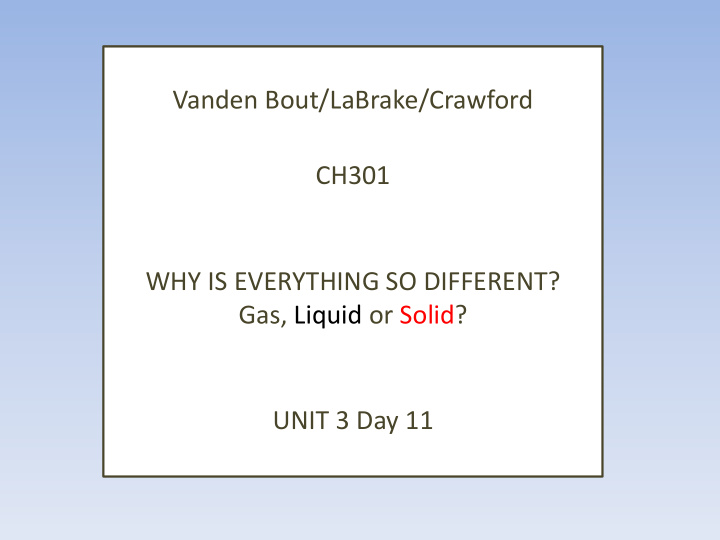



Vanden Bout/LaBrake/Crawford CH301 WHY IS EVERYTHING SO DIFFERENT? Gas, Liquid or Solid? UNIT 3 Day 11
What are we going to learn today? Properties of Solids – Different Types
Physical Properties Properties of Liquids based on intermolecular forces and shapes of molecules Properties of Solids based on intermolecular forces and the type of bonding
iclicker polling question Diamonds are a) A bunch of C atoms held together by dispersion forces b) A bunch of C molecules held together by dipole dipole interactions c) A bunch of C atoms covalently bound together d) A bunch of C molecules held together by dispersion forces
iclicker polling question Graphite is a) A bunch of C atoms held together by dispersion forces b) A bunch of C molecules held together by dipole dipole interactions c) A bunch of C atoms covalently bound together d) A bunch of C molecules held together by dispersion forces
iclicker polling question Solids are classified into four different categories Ionic Covalent Metallic Molecular We’ve already discussed two types of solids this semester. Which ones have we discussed? A. Ionic and Covalent B. Metallic and Covalent C. Molecular and Ionic D. Metallic and Molecular
Types of Solids Covalent or (Network) Ionic Metallic Molecular
Types of Solids Class Examples Characteristics Ionic NaCl, KNO 3, Hard, rigid, brittle; high CuSO 4 •H 2 O melting/boiling points; those soluble in water give conducting solutions Network B, C, black P, BN, Hard, rigid, brittle; very high melting SiO 2 points; insoluble in water Metallic s- and d - elements Malleable, ductile, lustrous; electrically and thermally conducting Molecular BeCl 2 , S 8 , P 4 , I 2 , ice, Relatively low melting/boiling points; glucose brittle if pure
Physical Properties of Solids Class Electrons Conductivity Ionic Localized Not a good conductor (only conducts electricity in aqueous solutions) Network Localized Not a good conductor Metallic Delocalized Good conductor Molecular Localized Not a good conductor
Physical Properties of Solids Ionic Metallic
Physical Properties of Solids Molecular Network
Learning Outcomes Recognize the four types of solids: ionic, covalent (network), metallic, and molecular Recognize how the macroscopic properties of solids (melting point, hardness, conductivity, etc.) can be explained by the microscopic model of solids
Recommend
More recommend